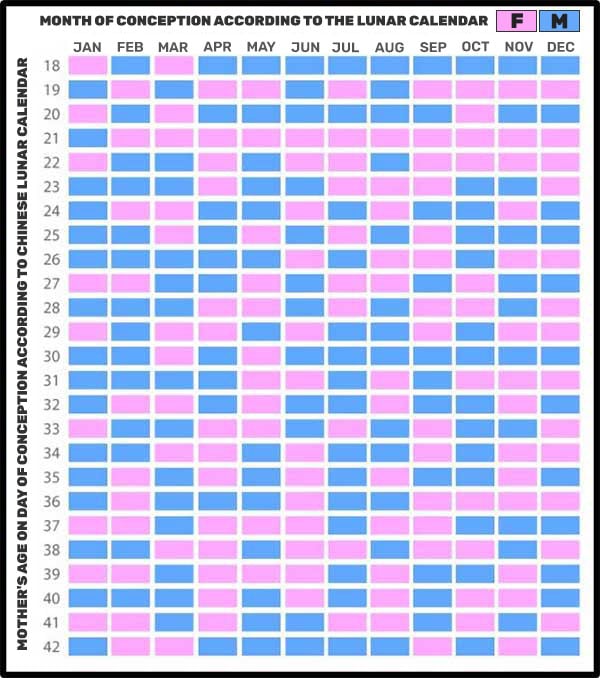Introduction
The Chinese pregnancy predictor chart, also known as the Chinese Gender Predictor Calendar Tool, is a technique developed by traditional Chinese medicine that claims to be able to predict the sex of a baby based on the Chinese lunar calendar.
The Chinese chart has gained a lot of popularity on the Internet, with hundreds of websites recommending this technique to pregnant women who are curious to know the sex of their baby. There are also those who recommend it to couples who haven’t yet conceived but want to be able to choose the sex of their future child. Supporters of the Chinese chart say that the technique is more than 90% effective. Some websites go further and claim that the calendar is 99% effective.
But what does science have to say about the Chinese gender chart? Are there any scientific studies on this method? If the Chinese chart is just folklore, a myth, why has it become so popular on the Internet?
What is the Chinese gender prediction chart?
Legend has it that the Chinese pregnancy chart was used by emperors as a guide to help them choose the sex of their future children, thus ensuring that they had male descendants, which guaranteed the continuity of the royal lineage.
Below is an example of the Chinese chart as published annually by the Chinese Farmers’ Almanac. In order to use the Chinese calendar, you need some tools to equate the Chinese calendar with our Western Gregorian calendar. These tools are easily found on the Internet.
This Chinese chart was not designed to be used with our traditional calendar (I will explain some differences between the calendars later).
Depending on the source you research, the history of the Chinese chart often shows some important differences. There are at least three different versions of the origin of the chart:
1. The most elaborate version of the story says that the Chinese baby gender prediction chart originated in the Qing Dynasty (1644-1912) and disappeared in the Summer Palace of Emperor Guangxu in 1900, after the dynasty lost the war with the Eight-Nation Alliance in that year.
At the end of the confrontation, the original table was sent to England, where the British monarchy kept it as treasure. Many years later, in 1972, under unclear circumstances, the chart turned up in Austria. There, it was seen by a Chinese historian who copied and published its contents in a Taiwanese newspaper. Since then, the chart has been published annually by the Chinese Farmers’ Almanac and is available in the delivery rooms of Chinese hospitals.
2. Another version of the chart’s origin is that it was found in a Qing Dynasty royal tomb near Beijing. The tablet would be about 700 years old, pre-dating the Qing Dynasty.
3. A third version says that the original Chinese chart was found in an underground room in the Forbidden City during the Qing Dynasty. The chart was designed based on the theory of Yin Yang, the five elements (metal, water, wood, fire, and earth) and Pa Kua.
Despite the different stories about its origin, all sources agree that the chart is based on the Chinese age of the mother and the month of conception, always according to the Chinese lunar calendar, with some significant differences when compared to our Western Gregorian calendar, which is based solely on the sun.
According to some sources, in China a baby is born at the age of 1 and turns 2 on the day of the Chinese New Year, which is usually between January and February, with no fixed annual date.
Therefore, to use the Chinese chart, you must first find out how old the mother is according to the Chinese calendar. In general, except for women born in January and February, the Chinese lunar age is one year older than the actual age.
For example, if you were born on August 30, 1990, and became pregnant on September 20, 2016, your actual age will be 26, but your Chinese age will be 27. On the other hand, if you were born on January 25, 1990, and became pregnant on September 20, 2016, your actual age and your Chinese age will be 26.
Issues with the Chinese calendar
In light of current scientific knowledge, the Chinese chart has numerous theoretical problems. None of the sources explain what is the relationship or the logic behind using the mother’s age and the month of conception to determine the baby’s sex.
What would be the rational explanation for us to believe, for example, that all 30-year-old women who conceive in June will always have male babies? And what is the reason that 21-year-old women only have a chance of having male children if conception occurs in January?
When this type of prediction, which defies common sense and conflicts with the law of probabilities, is made, we expect a good explanation to be provided, otherwise, the use of the chart is much closer to superstition than rationality.
But the foundational issues with the Chinese gender predictor chart are not limited to a mere lack of logical explanations about how it works. There are widely known issues that result in the chart’s low reliability. We will mention a few of them:
1. The first issue is knowing the exact date of conception. We know that in most cases, conception does not occur on the day of intercourse. Sperm can survive in the female reproductive tract for up to 5 or 6 days. Therefore, a woman who had intercourse on April 29 may not have ovulated (and been fertilized) until May 4. This means that all women who had intercourse in the last week of the month will have difficulty determining when they actually conceived.
What about women who have had several relationships in the last few months? How do you know the correct day of conception?
2. We know that the sex of a baby is “determined” by the male sperm, which carries either an X or Y sex chromosome. If the fertilizing sperm contains the Y chromosome, the resulting fetus will develop as male; if it carries the X chromosome, the fetus will develop as female. The genetic contribution of a woman has minimal or no influence on her baby’s sex. This is because her chromosomal pair is XX, meaning she can only contribute an X chromosome to her offspring.
It’s strange that the Chinese chart only takes into account the mother’s age and the month of conception. How can these data decide which type of sperm will be responsible for fertilization?
The woman’s body may have some influence on the choice of sperm. Still, for this to have any credibility, a plausible explanation is needed, preferably based on scientific data.
It’s interesting to remember that the chart was supposedly invented several centuries ago, when scientific knowledge was limited. It makes perfect sense that ancient peoples imagined that the woman’s body somehow determined the sex of the baby.
3. How can we explain the cases of women who have twins, each of a different sex?
4. If the table is effective, how can we explain the fact that the line of succession of Chinese emperors throughout history has not consisted entirely of male children?
What do scientific studies say?
Many websites that advocate for the Chinese chart often describe the chart as follows: “although there is no scientific proof, the chart has an impressive success rate”.
In fact, there is scientific proof. The problem is that the studies show exactly the opposite: the chart is unreliable and has a low success rate. Therefore, the scientific consensus exists, is that the chart is not reliable.
The most famous and important study on the Chinese chart was conducted in Sweden in 2010. In this study, researchers gathered data from about 3.4 million births that occurred between 1973 and 2006. Of these, researchers were able to obtain reliable data from mothers in about 2.8 million cases.
The success rate of the Chinese chart in this group of 2.8 million women was approximately 50%, i.e., precisely the expected efficacy rate for any test that does not work, such as trying to guess the baby’s sex through heads or tails. And the rate was always around 50%, regardless of the mother’s age or the month of conception.
This Swedish study is the largest, but not the only one. There are several studies published on the effect of the lunar calendar on pregnancy, not only on the baby’s sex but also on the birth date, risk of complications, baby’s development, and increased fertility. In all of them, no causal relationship between the lunar calendar and pregnancy outcomes could be proven.
Why is the Chinese chart so popular on the internet?
The Chinese chart has a 50% success rate. This means that of 3 million pregnant women, it will correctly “predict” the baby’s sex in 1.5 million.
Therefore, even with a high error rate, for 50% of the people who take the test, it will seem effective. The chance of the test correctly predicting the sex of two children is 25%, i.e., 750,000 women in a universe of 3 million pregnant women. That is why it is so common to find reports from mothers who guarantee that the chart is really reliable.
Conclusion: is the Gender Predictor Chart reliable?
From everything that has been explained so far, we can conclude, as expected, that the Chinese table for predicting the baby’s sex has no plausible theoretical basis and has failed when scientifically tested on a large group of women.
And it’s not just the baby’s gender that the chart gets wrong. So far, all the studies that have tried to find a relationship between the phases of the moon and pregnancy outcomes, whether it’s the date of delivery, the risk of complications, the health of the baby, etc., have been unsuccessful.
If you are pregnant and want to know the sex of your baby, the most reliable methods are the Non‐invasive prenatal testing (NIPT), which has a 99% accuracy rate from the 8th week of pregnancy, or the fetal ultrasound, which can identify the baby’s genitalia from the 14th week of pregnancy.
On a personal note, the author of this text has three daughters. The Chinese chart got the sex wrong for two of them.
References
- Accuracy of the Chinese lunar calendar method to predict a baby’s sex: a population-based study – Paediatric and perinatal epidemiology.
- The influence of lunar cycle on frequency of birth, birth complications, neonatal outcome and the gender: a retrospective analysis – Acta obstetricia et gynecologica Scandinavica.
- The effect of the lunar cycle on frequency of births and birth complications – American journal of obstetrics and gynecology.
- Chinese lunar calendar: Don’t paint the nursery just yet – University of Michigan.
Author(s)
Pedro Pinheiro holds a medical degree from the Federal University of Rio de Janeiro (UFRJ) and is a specialist in Internal Medicine and Nephrology, certified by the State University of Rio de Janeiro (UERJ) and the Brazilian Society of Nephrology (SBN). He is currently based in Lisbon, Portugal, with his credentials recognized by the University of Porto and the Portuguese Nephrology Specialty College.









Leave a Comment